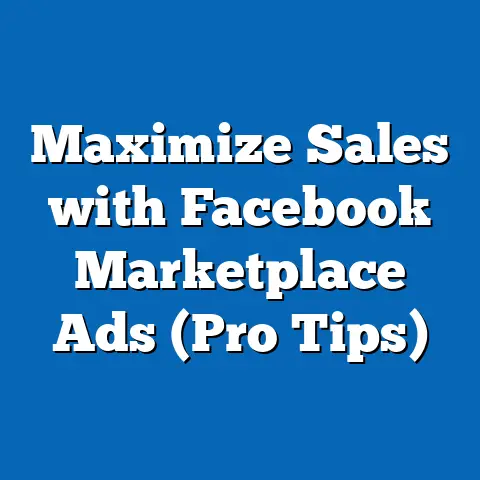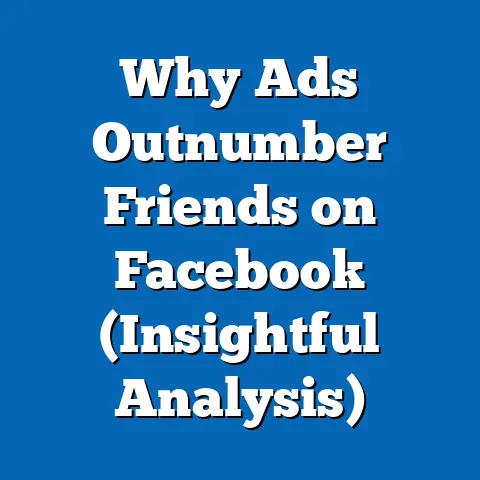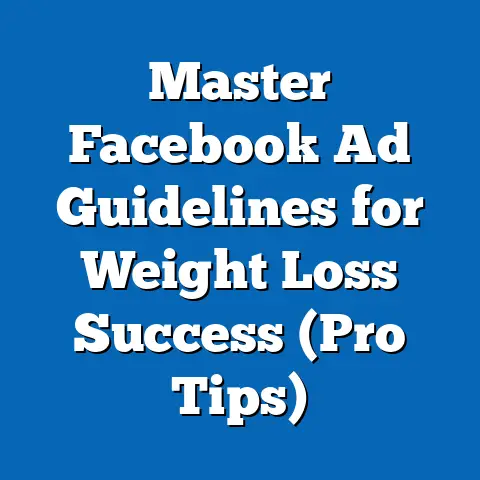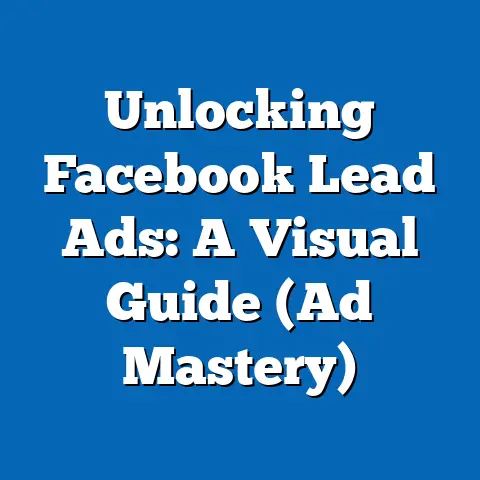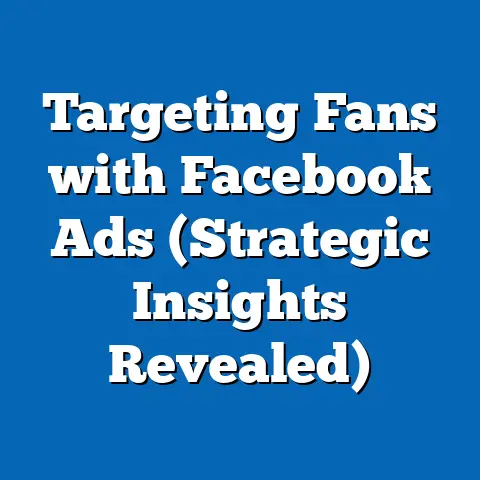Boost Facebook Ads with Balmer & Kalt Strategies (Pro Tips)
Facebook advertising can feel like navigating a vast ocean – full of potential, but also fraught with the risk of getting lost. I’ve spent years helping businesses navigate these waters, and one thing I’ve learned is that customizability is king. Facebook offers a mind-boggling array of options, allowing us to tailor campaigns with laser-like precision. But with so many choices, it’s easy to get overwhelmed. That’s where advanced methodologies like the Balmer & Kalt strategies come in.
These aren’t just buzzwords; they’re frameworks designed to maximize the efficacy of your Facebook Ads. We’re not just talking about vanity metrics like likes and shares. We’re talking about driving conversions, boosting your ROI, and turning ad spend into tangible business growth. In this guide, I’ll break down these strategies into actionable insights and pro tips you can implement today to boost your Facebook advertising efforts. Get ready to ditch the guesswork and start seeing real results!
Understanding the Balmer Strategy
The Balmer Strategy, in my experience, is all about understanding your audience inside and out. It’s about crafting messages that resonate with them on a deeply personal level. It’s also about leveraging data to make informed decisions, ensuring that every dollar spent is working its hardest.
Overview of the Balmer Strategy
At its core, the Balmer Strategy is a three-pillar approach: audience segmentation, creative personalization, and data-driven decision-making. It’s a holistic strategy that recognizes that success on Facebook isn’t about throwing money at a broad audience, but about engaging the right people with the right message at the right time.
- Audience Segmentation: This is the foundation. It involves breaking down your target audience into smaller, more manageable groups based on demographics, interests, behaviors, and even past interactions with your brand.
- Creative Personalization: Once you know who you’re talking to, you can tailor your ad creatives to resonate with them specifically. This means crafting different ad copy, visuals, and calls to action for each segment.
- Data-Driven Decisions: The Balmer Strategy isn’t a “set it and forget it” approach. It requires constant monitoring, analysis, and optimization based on real-time performance data.
Audience Segmentation
I’ve seen firsthand how impactful audience segmentation can be. Think of it this way: would you use the same sales pitch for a teenager and a retiree? Of course not! They have different needs, interests, and priorities. The same principle applies to your Facebook Ads.
Instead of targeting everyone who might be remotely interested in your product, focus on identifying distinct segments within your broader audience. Consider factors like:
- Demographics: Age, gender, location, education, income.
- Interests: Hobbies, passions, favorite brands, pages they follow.
- Behaviors: Purchase history, website activity, engagement with your content.
- Custom Audiences: People who have interacted with your website, app, or customer list.
For example, let’s say you’re selling organic skincare products. You could segment your audience into:
- Eco-conscious millennials: Target them with ads highlighting the sustainability and ethical sourcing of your ingredients.
- Moms seeking gentle skincare: Focus on the natural, hypoallergenic properties of your products.
- Mature women looking for anti-aging solutions: Emphasize the ingredients known for reducing wrinkles and promoting skin health.
By tailoring your message to each segment, you’ll increase relevance, improve engagement, and ultimately drive more conversions.
Creative Personalization
This is where the magic happens. Once you understand your audience segments, you can start crafting ad creatives that speak directly to their needs and desires.
- Ad Copy: Use language that resonates with each segment. Highlight the benefits that are most relevant to them. Avoid generic statements and focus on specific solutions.
- Visuals: Choose images and videos that appeal to each segment. Consider using different color schemes, models, and settings to create a more personalized experience.
- Calls to Action: Tailor your calls to action to match the stage of the customer journey. For example, a top-of-funnel ad might use a call to action like “Learn More,” while a bottom-of-funnel ad might say “Shop Now.”
A/B testing is your best friend here. Experiment with different ad creatives to see what resonates best with each segment. Don’t be afraid to try bold ideas and unconventional approaches. The key is to constantly learn and refine your approach based on data. I remember one campaign where simply changing the image from a stock photo to a user-generated image boosted conversions by over 30%!
Data-Driven Decisions
The Balmer Strategy is not a one-time setup; it’s an ongoing process of optimization. You need to constantly monitor your ad performance and adjust your strategy based on what’s working and what’s not.
Key metrics to monitor include:
- Click-Through Rate (CTR): This measures how often people click on your ads. A low CTR indicates that your ad copy or visuals aren’t resonating with your target audience.
- Cost Per Click (CPC): This measures how much you’re paying for each click. A high CPC could indicate that your targeting is too broad or that your ads aren’t relevant enough.
- Conversion Rate: This measures how often people take the desired action after clicking on your ad (e.g., making a purchase, filling out a form). A low conversion rate could indicate issues with your landing page or product offering.
- Return on Ad Spend (ROAS): This measures how much revenue you’re generating for every dollar spent on advertising. This is the ultimate metric for determining the success of your campaigns.
Facebook Ads Manager provides a wealth of data that you can use to track these metrics. Don’t just look at the overall numbers; drill down into each segment to see how they’re performing. Identify the segments that are driving the most conversions and focus your efforts on them.
Balmer Strategy Takeaway: The Balmer Strategy is your guide to deeply understanding and engaging your audience through personalized and data-driven advertising. Focus on segmentation, creative customization, and continuous optimization to maximize your ROI.
Exploring the Kalt Strategy
While the Balmer Strategy focuses on understanding and engaging your audience, the Kalt Strategy is all about guiding them through the sales funnel. It’s about strategically retargeting users based on their past interactions and delivering the right message at each stage of their journey.
Introduction to the Kalt Strategy
The Kalt Strategy is a perfect complement to the Balmer Strategy. While Balmer helps you identify and engage your audience, Kalt helps you convert them into customers. It focuses on two key concepts: strategic retargeting and the sales funnel approach.
- Strategic Retargeting: This involves re-engaging users who have previously interacted with your ads, visited your website, or engaged with your content.
- Sales Funnel Approach: This involves aligning your ads with different stages of the customer journey, from awareness to consideration to conversion.
Strategic Retargeting
Retargeting is one of the most powerful tools in your Facebook advertising arsenal. It allows you to re-engage users who have already shown interest in your brand, significantly increasing the likelihood of conversion.
Think about it: someone who has visited your website is much more likely to purchase your product than someone who has never heard of you. Retargeting allows you to capitalize on that existing interest and guide them towards a sale.
Here are some ways to use retargeting effectively:
- Website Visitors: Target users who have visited specific pages on your website. For example, if someone visited your product page but didn’t make a purchase, you can retarget them with an ad showcasing that product and offering a discount.
- Ad Engagers: Target users who have interacted with your previous ads (e.g., liked, commented, shared). This shows that they’re interested in your brand, so you can re-engage them with more targeted offers.
- Video Viewers: Target users who have watched a certain percentage of your video ads. This is a great way to nurture leads and move them further down the sales funnel.
- Customer Lists: Upload your customer list to Facebook and target them with special offers or promotions. This is a great way to reward loyal customers and encourage repeat purchases.
When creating retargeting ads, focus on providing value and addressing potential concerns. Offer discounts, free shipping, or exclusive content to incentivize them to take action.
Sales Funnel Approach
The sales funnel represents the customer journey from initial awareness to final purchase. It typically consists of three stages:
- Top of Funnel (Awareness): This is where you introduce your brand to new audiences. Focus on creating engaging content that captures their attention and educates them about your products or services.
- Middle of Funnel (Consideration): This is where you nurture leads and build trust. Share valuable content that addresses their pain points and positions your brand as a solution.
- Bottom of Funnel (Conversion): This is where you close the deal. Focus on driving conversions with targeted offers and persuasive messaging.
Your Facebook Ads should be aligned with each stage of the funnel.
- Top of Funnel Ads: These ads should be designed to generate awareness and capture attention. Use engaging visuals, compelling headlines, and a clear call to action (e.g., “Learn More,” “Discover Now”).
- Middle of Funnel Ads: These ads should focus on nurturing leads and building trust. Share valuable content, testimonials, and case studies that address their pain points and position your brand as a solution.
- Bottom of Funnel Ads: These ads should be designed to drive conversions. Use targeted offers, persuasive messaging, and a clear call to action (e.g., “Shop Now,” “Get a Quote,” “Sign Up Today”).
Using Lookalike Audiences
Lookalike audiences are a powerful way to expand your reach while maintaining relevance. They allow you to target new users who share similar characteristics to your existing customers or website visitors.
Facebook uses its vast database to identify users who are most likely to be interested in your products or services. You can create lookalike audiences based on:
- Customer Lists: Upload your customer list and Facebook will create a lookalike audience based on their demographics, interests, and behaviors.
- Website Visitors: Create a lookalike audience based on users who have visited your website.
- Page Engagers: Create a lookalike audience based on users who have liked or followed your Facebook page.
When creating lookalike audiences, start with your best-performing sources. For example, if you have a customer list of high-value customers, use that as your seed audience. Experiment with different audience sizes to find the sweet spot. Facebook allows you to choose a percentage range, from 1% (most similar) to 10% (broader reach).
Kalt Strategy Takeaway: The Kalt Strategy is all about guiding potential customers through the sales funnel with strategic retargeting and lookalike audiences. Align your ads with each stage of the customer journey to maximize conversions and build lasting relationships.
Pro Tips for Implementing Balmer & Kalt Strategies
Now that you understand the core principles of the Balmer & Kalt strategies, let’s dive into some pro tips that will help you implement them effectively.
Combining Strategies for Maximum Impact
The real power of the Balmer & Kalt strategies lies in their synergy. They’re not meant to be used in isolation; they’re designed to complement each other and create a comprehensive approach to Facebook advertising.
Here’s how you can combine them effectively:
- Start with Audience Segmentation (Balmer): Identify your key audience segments based on demographics, interests, behaviors, and past interactions.
- Personalize Your Ad Creatives (Balmer): Craft different ad copy, visuals, and calls to action for each segment.
- Align Your Ads with the Sales Funnel (Kalt): Determine which stage of the customer journey each segment is in and create ads that are tailored to their needs and desires.
- Implement Strategic Retargeting (Kalt): Retarget users who have interacted with your ads, visited your website, or engaged with your content.
- Leverage Lookalike Audiences (Kalt): Expand your reach by targeting new users who share similar characteristics to your existing customers.
- Continuously Monitor and Optimize (Balmer): Track your ad performance and adjust your strategy based on what’s working and what’s not.
By combining these strategies, you’ll create a powerful advertising engine that drives awareness, builds trust, and generates conversions.
Utilizing Facebook’s Advanced Tools
Facebook offers a range of advanced tools that can enhance your ad performance. Here are a few of my favorites:
- Dynamic Ads: These ads automatically showcase relevant products to users based on their past browsing behavior. This is a great way to personalize the shopping experience and drive conversions. I’ve seen dynamic ads increase click-through rates by as much as 50% in some campaigns.
- Facebook Pixel: This is a small piece of code that you install on your website. It allows you to track user behavior and create custom audiences for retargeting.
- Facebook Insights: This tool provides valuable data about your audience, including their demographics, interests, and behaviors.
- Facebook Attribution: This tool helps you understand which marketing channels are driving the most conversions.
Don’t be afraid to experiment with these tools and see how they can improve your ad performance.
Regular Performance Audits
Advertising on Facebook isn’t a “fire and forget” operation. Regular performance audits are essential for maintaining a healthy ROI and adapting to changes in audience behavior and platform algorithms.
Here’s a checklist of what to review during these audits:
- Ad Copy Effectiveness: Are your ad headlines and descriptions still resonating with your audience? Test different variations to see what performs best.
- Visual Engagement: Are your images and videos capturing attention and driving clicks? Refresh your visuals regularly to avoid ad fatigue.
- Audience Targeting: Are you targeting the right people? Review your audience demographics, interests, and behaviors to ensure they align with your ideal customer profile.
- Budget Allocation: Are you allocating your budget effectively? Identify your best-performing campaigns and allocate more resources to them.
- Landing Page Optimization: Are your landing pages optimized for conversions? Ensure they are mobile-friendly, load quickly, and have a clear call to action.
Staying Updated with Trends
Facebook is constantly evolving, so it’s important to stay updated with the latest trends and changes in advertising policies and features.
Here are some reliable resources for staying informed:
- Facebook Business Help Center: This is the official source for information about Facebook advertising.
- Facebook Marketing Science Blog: This blog shares insights and best practices from Facebook’s marketing science team.
- Industry Blogs and Publications: Follow reputable digital marketing blogs and publications to stay up-to-date on the latest trends.
- Facebook Advertising Communities: Join Facebook groups and forums to connect with other advertisers and share tips and strategies.
Pro Tips Takeaway: Combining the Balmer & Kalt strategies, leveraging Facebook’s advanced tools, conducting regular performance audits, and staying updated with trends are crucial for maximizing your Facebook advertising success.
Conclusion
Customizability is the name of the game in Facebook advertising. The Balmer & Kalt strategies provide a powerful framework for tailoring your campaigns to fit your unique goals and target audiences. By understanding your audience, personalizing your ad creatives, and aligning your ads with the sales funnel, you can drive awareness, build trust, and generate conversions.
I encourage you to start implementing the pro tips shared in this article to see tangible improvements in your Facebook advertising campaigns. Remember, success on Facebook isn’t about luck; it’s about strategy, data, and continuous optimization. With the right approach, you can unlock the full potential of Facebook advertising and achieve significant growth for your business. So, dive in, experiment, and watch your ROI soar!

